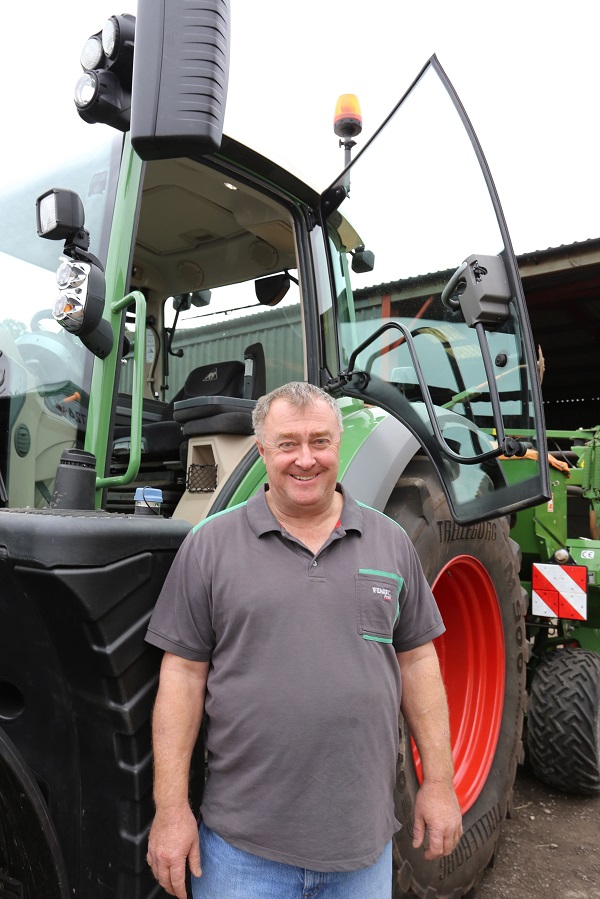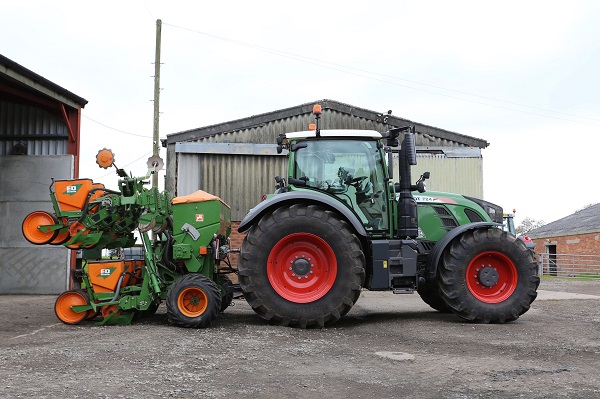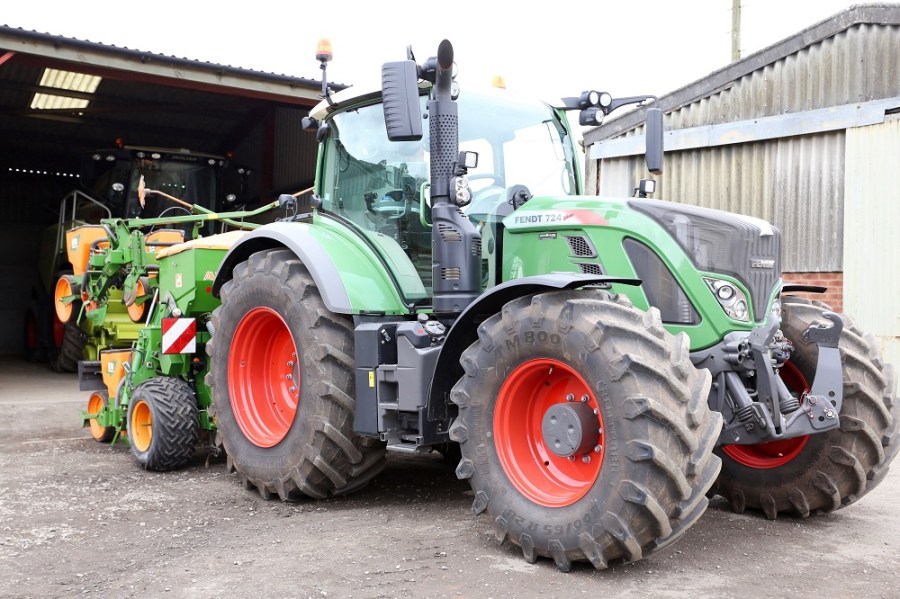When changing his tractor last year, a West Midlands arable farmer also had his well established foraging business to consider, along with fuel efficiency, versatility and residual value. CPM visited him to see what fitted the bill.
I’ve always thought they were too expensive, but I sat in one, tried it and loved it, then when we worked out the whole package, well, it was achievable.
By Jane Brooks
At a very early age, Andrew Brown who farms at Kings Norton near to Birmingham decided not to follow his father into the dairy industry.
“I came out of dairying when I got the tenancy of a 21ha farm and started from there. Now we’re tenants on 138ha, along with 53ha we share farm and a further 61ha contract farmed,” he says.
The soil in the area is mainly clay through to lighter soil and there’s a four-year rotation, two years of wheat and one of barley followed by a break crop.

Andrew Brown says he can see himself sticking with Fendt for the foreseeable future as he believes it’s a superior build.
“This year we’ve moved from JB Diego and are growing 124ha of Costello and KWS Siskin feed wheat for the first time. We’ve grown milling wheat, but it’s not too successful, possibly because we’re on late ground here. I’ve a friend just a few miles away at Wootten Wawen and he is always ahead of us with his combining.
“We’ve 41ha of Bazooka barley which is the same as last year although the yield was a bit disappointing, but I think barley was generally poor last year so we’re giving it another go. The other cropping is 32ha of oilseed rape and 14ha of Fuego beans, which will hopefully go for human consumption. The remainder is down to grass. We also bale all the wheat and barley straw and sell it to local livestock farmers.”

Driver comfort is superb, but as Andrew Brown pointed out, it needs to be when long hours are spent in the cab.
Andrew Brown is also a forage contractor, and a few years ago local contractors Jack and Bay Watson came along and helped him. Winners of the Agricultural Contractor category of a National Farming Award in 2012, the Watson Brothers offer a wide range of farming services.
In 2014, they joined forces as Watson and Brown, annually harvesting around 930ha of grass silage and 445ha of maize silage, which goes to local farmers. Maize is also harvested for the Severn Trent AD plant at Coleshill. They jointly run a Claas Jaguar 860 self-propelled forager and share other machinery as and when necessary while still maintaining their own separate enterprises.
“Our 243ha combined with the additional contracting work is a reasonable size to make a living out of and I was looking for a new tractor to suit both businesses. If we just had our 243ha without the forage harvesting I wouldn’t have been looking,” notes Andrew Brown.
“The Watson brothers had a Fendt on demonstration but I didn’t really look at it or drive it, and to be honest I’d always thought they were too expensive. But our local dealers Lister Wilders had a Fendt 724 at their Southam branch and I had a test drive on that.
“I absolutely loved it and once we had worked the whole package out it wasn’t as expensive as I thought,” he explains, before adding, “Well it was still expensive but it was doable. Also, I hope the higher purchase cost will be offset by a significantly higher residual value and also by greater fuel economy, but time will tell on that one.”
The Fendt 724 uses a six-cylinder Deutz 6.6-litre engine, which coupled with AGCO emissions technology meets Tier 4 final standards. Rated at 240hp, The engines are turbocharged, have air-to-air after cooling and through their multiple injection system allow the use of biodiesel fuels.
In addition to selective catalytic reduction (SCR) technology, as well as utilising cooled exhaust gas recirculation cEGR, AGCO have also introduced a catalyst called a CSF (coated soot filter).
AGCO say this filter allows for automatic cleaning of the system while the tractor is in use, the filter doesn’t require any maintenance and there’s no need to go through a regeneration cycle that requires the operator to stop or turn off the tractor, which should improve fuel economy and reduce maintenance.
Andrew Brown is particularly impressed with the cab lay out – all the operating functions are placed on the right armrest, which moves along with the driver’s seat. Additionally, the Varioterminal 10.4B offers touch-screen technology.
The terminal controls the VarioGuide automatic steering system and Variotronic IM implement control if either are used. It also has the VarioDoc function which stores maintenance and other records, it’s also compatible with different field record systems.
The steering wheel is height and tilt adjustable. The instrument cluster swings along with it and therefore should always remain in a useable position. Air-conditioning is standard and automatic climate control is available as an option.
“It’s such a good cab to sit in, just a nice environment, particularly with the window that goes right up over your head, it’s lovely to use which is what you need when you’re spending a lot of time in the tractor seat,” says Andrew Brown.
“The Fendt replaced a Massey Ferguson 6499 and is the first CVT we’ve had, it took a couple of days to get used to it but I find it much better than a standard gearbox and wouldn’t go back now,” he adds.
“So far it’s done 850 hours, I didn’t go for the front PTO option, although it does have the front lift on it but I do have the optional higher oil flow rate of 152 l/min. It’s used a lot for trailer work and it gives full hydraulic power at 1100 revs so you don’t have to rev seven bells out of it when you’re tipping a trailer.
“Handing is good – it’s a bit shorter than the Massey Ferguson and has a tight turning circle, so we find very little to complain about. Fuel economy is excellent when it’s on trailer work but if you put it on the Sumo and work it hard it will consume fuel.”
Oil change intervals on the Fendt’s Vario transmission are 2000 hours. What’s more, the hydraulic oil system is completely separate from the transmission oil. Each has a separate reservoir, so there’s no risk of contaminating the transmission if an implement has some grubby old oil in it.
Currently within the contracting business they use 12t trailers, mainly to enable grass and maize silage to be tipped in the clamps at some of the smaller dairy farms they harvest for, but the plan is to add a pair of 14t trailers in the future.
The tractor is used on the maize drill, a big square baler, for ploughing and on the power harrow, and according to Andrew Brown does everything it says on the tin. He says it’s near to its power limit on the Sumo, although he also points out it would be just the same for tractors of similar horsepower.
“We do have a small problem with blackgrass on the farm – we had one piece that was quite bad last year so we ploughed it rather than using the Sumo, but we’re hoping the OSR will sort the job out. We plough the lighter ground if we need to, but try not to plough the marly clay. Usually one tractor will pull the plough and another will have the Sumo and we go over with one or the other, then we use the CultiPress or the power harrow to prepare a seed bed.
“I don’t class the Sumo as min-till as it’s moving all the soil, also on our contracting costing, if we plough and work the soil or use the Sumo and work it, there’s very little time or price difference, so it’s not much of a saving.
“Our agronomist pretty much has a free rein on all the crop protection decisions,” he continues. “He does all the field walking and soil sampling then comes up with a plan and we buy whatever we need from him, which works for us.”
Spraying is carried out with a self-propelled Househam 24m boom sprayer, which suits the farm’s field size. Quite a bit of sewage sludge is also applied post-harvest, brought in and spread by Severn Trent’s own team of contractors.
“We use whatever is needed to maintain a clean crop including fungicides, herbicides and pesticides. But when you look at the future of establishing wheat and clean crops if glyphosate is banned, then we’ve had it and might as well not bother. We don’t do variable spreading at the moment but will probably do so if we’re on GPS, but one step at a time.”
He says he’s not yet convinced about GPS and auto-steering, although the Fendt is ISOBUS and autosteer ready so he’s been looking into GPS and is considering Lister Wilder’s RTK system.
“I’d looked at simple systems, but worry they may become out dated. I do think you have to be certain it’s going to be cost effective, but if we do use it we may as well go for the full job from the start.”
To date, Andrew Brown has had very few technical problems with the Fendt 724. “We had a minor Adblue problem – some of it dried on to a sensor and it went into limp mode – but Lister Wilder came out and fixed it. Generally, it’s got the power we need and is everything I expected, the plan is to keep it for six years,” he adds.
“There’s a good warranty on it and I would say personally I’m pretty much converted to Fendt and would buy it again but with the proviso that I need to see how it lasts and also how it holds its value – perhaps I’ll have a better answer in six years’ time.”
The verve that makes a Vario
Fendt’s Vario continuously variable transmission (CVT) was originally designed by Fendt development engineer Hans Marshall back in the 1970s. Fendt’s first CVT tractors went into production in 1996 when the Fendt 926 Vario was launched. Up until this time, Power Shift transmission was pretty much the industry standard.
At the heart of the original system, Vario comprises a variable output hydraulic pump and a pair of variable output hydraulic motors, which work together with mechanical drive components and include a single planetary gear set on the power input side. Although the system has undergone a few technical upgrades, very little has actually changed and the principle remains the same.
The hydrostatic-mechanical power split drive progressively alters the proportion of drive delivered by the mechanical and hydraulic components. There’s no clutch pack and no gears to change and also no ranges to change while you’re in a working mode, it’s all seamless.
There’s just a two-stage transmission, which serves two pre-selectable ranges – field or transport. It basically has two gears and the hydrostat that allows stepless acceleration from a standstill to the maximum speed in the range. When in reverse, the transmission is always set to hydrostatic control.
So with CVT transmission, you can select your speed – 10km/h for instance – and the engine revs will adjust to maintain that speed. Also if you need a bit more oomph if you’re using an implement and hit some hard ground the CVT automatically adjusts the rpm to get through and maintain the same speed. The result is a completely stepless acceleration from 0-50km/h.
Farm Facts
Redhill Farm, Kings Norton, Birmingham, West Midlands
- Farmed area: 251ha total
- Cropping: 123.5ha wheat, 40.5ha barley, 32ha OSR, 14ha beans, remainder grassland.
- Agronomist: David Vine of Agrii
- Soils: Heavy clay to loam
- Elevation :150m above sea level
- Mainline Tractors:2016 Fendt 724; 2014 Massey Ferguson 7620; 2011 Massey Ferguson 6480
- Telehandler:2010 JCB 526 Loadall
- Combine: Claas Lexion 630 with 6.8m header
- Drill: Amazone ED 602 8-row maize dril;l KRM Solo 4.8m
- Cultivation: Simba CultiPress; Kuhn 5M power-harrow; Sumo Trio
- Plough: 5f Gregoire Besson
- Sprayer: Self-propelled 2004 Househam AR 3000 with 24m boom
- Spreader: KRM M2
- Baler: Massey Ferguson 2150
- Staff: Andrew Brown and 2 seasonal workers.




